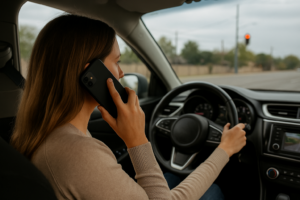Phoenix, Arizona Uber & Lyft Rideshare Accident Attorneys
Talk With Us TodayArizona
(602) 900-9402Uber and Lyft Rideshare Accident Attorneys
In Arizona’s rapidly evolving transportation landscape, rideshare services have become an integral part of daily life. As part of a $95.8 billion global industry, Uber and Lyft provide convenient transportation options but also present unique legal challenges when accidents occur. While over 99.9% of rides occur without incident, understanding your rights and legal options after a rideshare accident is crucial for protecting your interests.
Uber & Lyft Rideshare Insurance Coverage in Arizona
Rideshare insurance coverage in Arizona follows a tiered structure based on the driver’s status at the time of the accident. Understanding these phases is critical for personal injury victims seeking compensation:
1. App Off (Driver’s Personal Insurance)
Coverage: When the rideshare app is turned off, the driver is considered using their vehicle for personal purposes. In this phase, only the driver’s personal auto insurance applies. Arizona law requires minimum liability coverage of:
$25,000 for bodily injury per person
$50,000 for bodily injury per accident
$15,000 for property damage
Impact on Victims: If the rideshare driver causes a crash while not logged into the app, victims can only recover compensation through the driver’s personal insurance policy. These minimum limits may be too low to fully cover the costs of serious injuries or extensive property damage.
2. App On, Awaiting Ride Request (Period 1)
Coverage: Once the driver is logged into the app and waiting for a ride request, Uber and Lyft provide third-party liability coverage. In Arizona, this includes:
$25,000 for bodily injury per person
$50,000 for bodily injury per accident
$20,000 for property damage
Impact on Victims: These limits provide more protection than when the driver is completely offline, but they may still fall short in cases involving multiple injuries or severe trauma. Victims should know that this phase offers limited compensation compared to the next tier.
3. En Route to Pick-Up or During Ride (Periods 2 & 3)
Coverage: When a ride has been accepted or a passenger is in the vehicle, both Uber and Lyft provide significantly more coverage:
$1 million in third-party liability coverage
Uninsured/Underinsured Motorist (UM/UIM) coverage
Contingent comprehensive and collision coverage (if the driver has personal collision coverage)
Impact on Victims: This is the most robust coverage available. The $1 million policy can cover extensive injuries, lost wages, and other damages. UM/UIM coverage is crucial if another driver causes the crash but lacks adequate insurance. Contingent comprehensive and collision may also help cover vehicle damage, indirectly aiding passengers in a personal injury claim.
Were you or someone you know Injured?
Immediate Steps After a Rideshare Accident
The moments following a rideshare accident are critical for your safety and potential legal case. Taking proper action immediately can significantly impact your ability to receive fair compensation for injuries and damages.
- Ensure safety and call 911 if there are injuries
- Document everything with photos and videos
- Screenshot your rideshare app showing trip details
- Collect witness information and driver details
- Seek medical attention, even for minor injuries
- Report the accident through the rideshare app
- Contact an experienced rideshare accident attorney
Accident Statistics and Risk Factors
Recent data reveals both concerning trends and positive developments in rideshare safety. While overall traffic fatalities have decreased, specific risks associated with rideshare operations require attention.
- Motor vehicle fatalities constitute 0.000005% of Uber trips and 0.000006% of Lyft trips
- A 3% annual increase in vehicular deaths linked to rideshare services
- Approximately 987 additional roadway deaths annually attributed to rideshare drivers
- Ridesharing has reduced alcohol-related traffic deaths by 6.1%
- Overall traffic fatalities reduced by 4% since rideshare introduction
Common Causes of Rideshare Accidents
Understanding the primary causes of rideshare accidents helps both drivers and passengers recognize potential dangers and take preventive measures.
- Distracted driving (app usage, GPS navigation)
- Driver fatigue from extended hours
- Unfamiliarity with routes or areas
- Time pressure to accept rides
- Sudden stops for passenger pickup
- Weather-related incidents
- Vehicle maintenance issues
We Fight for Victims of Rideshare Accidents
Legal Considerations in Arizona
Arizona’s legal framework provides specific guidelines for handling rideshare accident claims. Understanding these requirements helps protect your rights and ensure proper compensation.
Time Limits and Requirements
- 2-year statute of limitations for personal injury claims
- 180 days to file notice if government entity involved
- Specific documentation requirements for rideshare cases
- Mandatory insurance verification process
Compensation Types Available
A comprehensive claim may include various forms of compensation depending on the accident’s circumstances and resulting damages.
- Medical expenses (current and future)
- Lost wages and earning capacity
- Pain and suffering
- Property damage
- Emotional distress
- Rehabilitation costs
- Long-term care expenses
The Rideshare Accident Claims Process
If you’ve been injured in a rideshare accident—whether as a passenger, another driver, or a pedestrian—it’s important to understand the steps involved in filing a claim. The process can be more complex than a typical car accident due to the involvement of rideshare companies and multiple insurance policies. Here’s a step-by-step breakdown:
1. Seek Medical Attention Immediately
Your health comes first. Even if your injuries seem minor, get checked out by a medical professional. Medical records will also serve as critical evidence in your claim.
2. Report the Accident
To Authorities: Call 911 and request a police report, especially if there are injuries or property damage.
To the Rideshare Company: Report the incident through the app. Both Uber and Lyft have in-app tools for filing accident reports.
To Your Insurance (if applicable): Depending on your role in the accident, notify your insurance provider as well.
3. Document Everything
Take photos of the accident scene, vehicle damage, road conditions, and visible injuries.
Get the names and contact information of all drivers, passengers, and witnesses.
Save copies of the rideshare trip receipt, correspondence with insurance companies, and medical bills.
4. Consult a Rideshare Accident Attorney
Liability in rideshare accidents is not always straightforward. An experienced attorney can help you:
Determine which insurance policy applies (Uber/Lyft vs. personal insurance)
Evaluate your damages
Deal with complex claims involving multiple parties
5. File the Injury Claim
Your attorney will help you file a claim with the appropriate insurance carrier—this may be the rideshare company’s insurer or another driver’s insurer, depending on fault. The claim will include documentation of:
Medical expenses
Lost wages
Pain and suffering
Property damage (if applicable)
6. Negotiate or Litigate
Most rideshare accident claims settle out of court. However, if the insurance company refuses a fair settlement, your attorney may file a lawsuit to pursue full compensation in court.
Time Is Critical
Arizona law gives you two years from the date of the accident to file a personal injury lawsuit. Missing this deadline can result in losing your right to recover compensation.
FAQ
How long do I have to file a claim?
You have 2 years from the accident date for personal injury claims, but only 180 days if a government entity is involved.
What insurance applies during a rideshare accident?
Coverage depends on the driver’s status in the app, ranging from personal insurance to $1 million in liability coverage.
Should I accept a quick settlement?
No, consult with an attorney first to understand your full rights and potential compensation.
Who can be held liable in a rideshare accident?
Multiple parties may be liable, including the driver, rideshare company, other motorists, or vehicle manufacturers.
Contact Ramos Law
If you or a loved one was a victim of a rideshare accident, Ramos Law will help you understand your rights and fight for the compensation you deserve.
Contact a Food Poisoning Attorney Now

Arizona’s Laws Regarding Cell Phone Use While Driving
Cell Phone Laws While Driving in Arizona In Arizona, it is illegal to use a handheld cell phone while driving, but hands-free use is permitted. You may use a device with Bluetooth, an earpiece, speakerphone, or wrist-worn functionality, as long as it doesn’t require holding or visual attention that distracts

How to Prove Insurance Bad Faith in Arizona
Table of Contents Arizona Insured Should How to Prove Insurance Bad Faith in Arizona Insurance companies are legally obligated to handle claims fairly, but sometimes they prioritize profits over policyholders. When an insurer unfairly denies, delays, or underpays a valid claim, it may be acting in bad faith, which is





